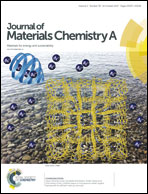In situ growth of a TiO2 layer on a flexible Ti substrate targeting the interface recombination issue of BiVO4 photoanodes for efficient solar water splitting†
Abstract
Unfavorable interfacial electron back-injection, sluggish surface kinetics, and poor bulk conductivity leading to remarkable recombination are the key issues which significantly hinder the solar-to-hydrogen efficiency of PEC photoanodes. In this study, Ti foil is employed as the substrate for fabricating BiVO4 photoanodes. Surface passivation of TiO2 is sophisticatedly designed to block interface recombination in solar water splitting for the first time, so that a significant two-fold increase in photocurrent and a large decrease in dark current are observed. In addition, to address the other two issues, CoOx oxygen evolution catalysts (OECs) and Mo/N doping are applied to increase the photocurrent density and applied bias photon-to-current efficiency to 5.04 mA cm−2 at 1.23 VRHE and 1.41% at 0.75 VRHE, respectively, under AM 1.5 G illumination, which suggests the great potential of integrating strategies to target specific issues in BiVO4 photoanodes.



 Please wait while we load your content...
Please wait while we load your content...